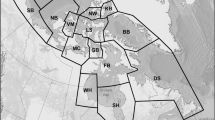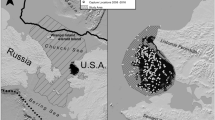Abstract
Quantifying the degree of site fidelity in polar bears’ (Ursus maritimus) use of denning and mating areas in spring is of considerable interest for both basic and applied purposes. We analyzed 276 spring-to-spring movements (displacements) of 178 polar bears obtained from mark-recapture in the period 1987–2010 in Svalbard, Norway. Male and female subadults and adults showed site fidelity (only subadult females non-significantly) when their movements were compared to a scenario of random movements between all capture locations. The median observed displacement was 47.6 km (bootstrapped 95 % CI: 38.6–57.8 km), significantly smaller than the median potential displacement for random movements of 206.3 km (bootstrapped 95 % CI: 187.3–219.6 km). Subadult females tended to have the longest displacements, followed by adult males and adult females. However, large individual variation both in displacement distances and recapture frequency tended to blur age and sex differences. Analysis restricted to one movement for each bear showed that the difference between adult males and adult females was small and non-significant. This indicates that findings based on telemetry, which is almost always restricted to females, may be relatively representative of the whole adult Barents Sea population in the spring season.








Similar content being viewed by others
References
Afshartous D, Preston RA (2010) Confidence intervals for dependent data: equating non-overlap with statistical significance. Comput Stat Data Anal 54:2296–2305
Amstrup SC (2003) Polar bear, Ursus maritimus. In: Feldhamer GA, Thompson BC, Chapman JA (eds) Wild mammals of North America: biology, management, and conservation. The Johns Hopkins University Press, Baltimore, pp 587–610
Amstrup SC, Gardner C (1994) Polar bear maternity denning in the Beaufort Sea. J Wildl Manag 58:1–10
Amstrup SC, Durner GM, McDonald TL, Mulcahy DM, Garner GW (2001) Comparing movement patterns of satellite-tagged male and female polar bears. Can J Zool 79:2147–2158
Andersen M, Derocher AE, Wiig Ø, Aars J (2008) Movements of two Svalbard polar bears recorded using geographical positioning system satellite transmitters. Polar Biol 31:905–911
Andersen M, Derocher AE, Wiig Ø, Aars J (2012) Polar bear (Ursus maritimus) maternity den distribution in Svalbard, Norway. Polar Biol 35:499–508
Bennetts RE, Nichols JD, Lebreton JD, Pradel R, Hines JE, Kitchens WM (2001) Methods for estimating dispersal probabilities and related parameters using marked animals. In: Clobert J, Danchin E, Dhondt AA, Nichols JD (eds) Dispersal. Oxford University Press, Oxford, pp 3–17
Bethke R, Taylor MK, Amstrup SC, Messier F (1996) Population delineation of polar bears using satellite collar data. Ecol Appl 6:311–317
Born EW, Wiig Ø, Thomassen J (1997) Seasonal and annual movements of radio-collared polar bears (Ursus maritimus) in northeast Greenland. J Mar Syst 10:67–77
Box GEP, Cox DR (1964) An analysis of transformations. J Roy Stat Soc Ser B 26:211–252
Christensen-Dalsgaard SN, Aars J, Andersen M, Lockyer C, Yoccoz NG (2010) Accuracy and precision in estimation of age of Norwegian Arctic polar bears (Ursus maritimus) using dental cementum layers from known-age individuals. Polar Biol 33:589–597
Clobert J, Wolff JO, Nichols JD, Danchin E, Dhondt AA (2001) Introduction. In: Clobert J, Danchin E, Dhondt AA, Nichols JD (eds) Dispersal. Oxford University Press, Oxford, pp 17–21
Crompton AE, Obbard ME, Petersen SD, Wilson PJ (2008) Population genetic structure in polar bears (Ursus maritimus) from Hudson Bay, Canada: implications of future climate change. Biol Conserv 141:2528–2539
Derocher AE (2005) Population ecology of polar bears at Svalbard, Norway. Popul Ecol 47:267–275
Derocher AE, Stirling I (1996) Aspects of survival in juvenile polar bears. Can J Zool 74:1246–1252
Derocher AE, Wiig Ø (2002) Postnatal growth in body length and mass of polar bears (Ursus maritimus) at Svalbard. J Zool 256:343–349
Derocher AE, Andersen M, Wiig Ø, Aars J, Hansen E, Biuw M (2011) Sea ice and polar bear den ecology at Hopen Island, Svalbard. Mar Ecol Prog Ser 441:273–279
Dobson SF (1982) Competition for mates and predominant juvenile male dispersal in mammals. Anim Behav 30:1183–1192
Durner GM, Amstrup SC, Fischbach AS (2003) Habitat characteristics of polar bear terrestrial maternal den sites in northern Alaska. Arctic 56:55–62
Durner GM, Douglas DC, Nielson RM, Amstrup SC, McDonald TL, Stirling I, Mauritzen M, Born EW, Wiig Ø, DeWeaver E, Serreze MC, Belikov SE, Holland MM, Maslanik J, Aars J, Bailey DA, Derocher AE (2009) Predicting 21st-century polar bear habitat distribution from global climate models. Ecol Monogr 79:25–58
Ferguson SH, Taylor MK, Born EW, Messier F (1998) Fractals, sea-ice landscape and spatial patterns of polar bears. J Biogeogr 25:1081–1092
Ferguson SH, Taylor MK, Messier F (2000) Influence of sea ice dynamics on habitat selection by polar bears. Ecology 81:761–772
Freitas C, Kovacs KM, Andersen M, Aars J, Sandven S, Skern-Mauritzen M, Pavlova O, Lydersen C (2012) Importance of fast ice and glacier fronts for female polar bears and their cubs during spring in Svalbard, Norway. Mar Ecol Prog Ser 447:289–304
Gandon S (1999) Kin competition, the cost of inbreeding and the evolution of dispersal. J Theor Biol 200:345–364
Garner GW, Belikov SE, Stishov MS, Barnes VG, Arthur SM (1994) Dispersal patterns of maternal polar bears from the denning concentration on Wrangel Island. Int Conf Bear Res Manag 9:401–410
Gerland S, Renner AHH, Godtliebsen F, Divine D, Loyning TB (2008) Decrease of sea ice thickness at Hopen, Barents Sea, during 1966–2007. Geophys Res Lett 35:1–5
Greenwood PJ (1980) Mating systems, philopatry and dispersal in birds and mammals. Anim Behav 28:1140–1162
Hansson R, Thomassen J (1983) Behavior of polar bears with cubs in denning area. Int Conf Bear Res Manag 5:246–254
Jensen SK, Aars J, Lydersen C, Kovacs KM, Åsbakk K (2010) The prevalence of Toxoplasma gondii in polar bears and their marine mammal prey; evidence for a marine transmission pathway? Polar Biol 33:599–606
Koenig WD, VanVuren D, Hooge PN (1996) Detectability, philopatry, and the distribution of dispersal distances in vertebrates. TREE 11:514–517
Laidre KL, Stirling I, Lowry LF, Wiig Ø, Heide-Jorgensen MP, Ferguson SH (2008) Quantifying the sensitivity of arctic marine mammals to climate-induced habitat change. Ecol Appl 18:S97–S125
Larsen T (1985) Polar bear denning and cub production in Svalbard, Norway. J Wildl Manag 49:320–326
Larsen T (1986) Population biology of the polar bear (Ursus maritimus) in the Svalbard area. Norsk Polarinst Skri 184:1–55
Lawson Handley LJ, Perrin N (2007) Advances in our understanding of mammalian sex-biased dispersal. Mol Ecol 16:1559–1578
Lentfer JW (1983) Alaskan polar bear movements from mark and recovery. Arctic 36:282–288
Loeng H (1991) Features of the physical oceanographic conditions of the Barents Sea. Polar Res 10:5–18
Lønø O (1970) The polar bear (Ursus maritimus Phipps) in the Svalbard area. Norsk Polarinst Skri 149:1–115
Lydersen C, Gjertz I (1986) Studies of the ringed seal, Phoca hispida Schreber 1775, in its breeding habitat in Kongsfjorden, Svalbard. Polar Res 4:57–63
Manchi S, Swenson JE (2005) Denning behaviour of Scandinavian brown bears Ursus arctos. Wildli Biol 11:123–132
Mauritzen M, Derocher AE, Wiig Ø (2001) Space-use strategies of female polar bears in a dynamic sea ice habitat. Can J Zool 79:1704–1713
Mauritzen M, Derocher AE, Wiig Ø, Belikov SE, Boltunov AN, Hansen E, Garner GW (2002) Using satellite telemetry to define spatial population structure in polar bears in the Norwegian and western Russian Arctic. J Appl Ecol 39:79–90
Mauritzen M, Belikov SE, Boltunov AN, Derocher AE, Hansen E, Ims RA, Wiig Ø, Yoccoz N (2003a) Functional responses in polar bear habitat selection. Oikos 100:112–124
Mauritzen M, Derocher AE, Pavlova O, Wiig Ø (2003b) Female polar bears, Ursus maritimus, on the Barents Sea drift ice: walking the treadmill. Anim Behav 66:107–113
Mulcahy DM, Garner G (1999) Subcutaneous implantation of satellite transmitters with percutaneous antennae into male polar bears (Ursus maritimus). J Zoo Wildl Med 30:510–515
Nichols JD (1992) Capture-recapture models. Bioscience 42:94–102
Obbard ME, Thiemann GW, Peacock E, DeBruyn TD (eds) (2010). Polar bears: Proceedings of the 15th working meeting of the IUCN/SSC polar bear specialist group, Copenhagen, Denmark, 29 June–3 July 2009. Gland, Switzerland and Cambridge, UK: IUCN. pp 235–237
Paetkau D, Calvert W, Stirling I, Strobeck C (1995) Microsatellite analysis of population-structure in Canadian polar bears. Mol Ecol 4:347–354
Paetkau D, Amstrup SC, Born EW, Calvert W, Derocher AE, Garner GW, Messier F, Stirling I, Taylor MK, Wiig Ø, Strobeck C (1999) Genetic structure of the world’s polar bear populations. Mol Ecol 8:1571–1584
Piechura J, Walczowski W (2009) Warming of the West Spitsbergen current and sea ice North of Svalbard. Oceanologia 51:147–164
Pusey AE (1987) Sex-biased dispersal and inbreeding avoidance in birds and mammals. TREE 2:295–299
R Development Core Team (2010) R: a language and environment for statistical computing. R Foundation for Statistical Computing, Vienna
Ramsay MA, Stirling I (1990) Fidelity of female polar bears to winter-den sites. J Mammal 71:233–236
Schweinsburg RE, Furnell DJ, Miller SJ (1981) Abundance, distribution and population structure of polar bears in the lower central Arctic islands. Wildlife service completion Rep No 2, government of the Northwest territories, Yellowknife
Schweinsburg RE, Lee LJ, Latour PB (1982) Distribution, movement and abundance of polar bears in Lancaster Sound, Northwest Territories. Arctic 35:159–169
Stirling I, Spencer C, Andriashek D (1989) Immobilization of polar bears (Ursus maritimus) with Telazol in the Canadian Arctic. J Wildl Dis 25:159–168
Stirling I, Lunn NJ, Iacozza J, Elliott C, Obbard M (2004) Polar bear distribution and abundance on the Southwestern Hudson Bay coast during open water season, in relation to population trends and annual ice patterns. Arctic 57:15–26
Switzer PV (1993) Site fidelity in predictable and unpredictable habitats. Evol Ecol 7:533–555
Talbot S, Shields G (1996) A phylogeny of the bears (Ursidae) inferred from complete sequences of three mitochondrial genes. Mol Phylogenet Evol 5:567–575
Taylor MK, Akeeagok S, Andriashek D, Barbour W, Born EW, Calvert W, Cluff HD, Ferguson S, Laake J, Rosing-Asvid A, Stirling I, Messier F (2001) Delineating Canadian and Greenland polar bear (Ursus maritimus) populations by cluster analysis of movements. Can J Zool 79:690–709
Vinje T (1985) The physical environment western Barents Sea: drift, composition, morphology and distribution of the sea ice fields in the Barents Sea. Norsk Polarinst Skri 179C:1–26
Wiig Ø (1995) Distribution of polar bears (Ursus maritimus) in the Svalbard area. J Zool 237:515–529
Wiig Ø, Born EW, Pedersen LT (2003) Movements of female polar bears (Ursus maritimus) in the East Greenland pack ice. Polar Biol 26:509–516
Zeyl E, Aars J, Ehrich D, Bachmann L, Wiig Ø (2009a) The mating system of polar bears: a genetic approach. Can J Zool 87:1195–1209
Zeyl E, Aars J, Ehrich D, Wiig Ø (2009b) Families in space: relatedness in the Barents Sea population of polar bears (Ursus maritimus). Mol Ecol 18:735–749
Zeyl E, Ehrich D, Aars J, Bachmann L, Wiig Ø (2010) Denning-area fidelity and mitochondrial DNA diversity of female polar bears (Ursus maritimus) in the Barents Sea. Can J Zool 88:1139–1148
Acknowledgments
This paper is based on 24 years of capture-mark-recapture efforts in Svalbard, and we would like to thank all who have been involved with the Norwegian Polar Institute’s polar bear monitoring program in the period 1987–2010, especially former program leaders Øystein Wiig and Andy Derocher, and Magnus Andersen that has been involved in data collection from year 2000. Thanks to John-André Henden and Harry P. Andreassen for comments on the manuscript. The comments of Martyn E. Obbard, Matthew A. Cronin, and one anonymous reviewer greatly improved the manuscript.
Author information
Authors and Affiliations
Corresponding author
Rights and permissions
About this article
Cite this article
Lone, K., Aars, J. & Ims, R.A. Site fidelity of Svalbard polar bears revealed by mark-recapture positions. Polar Biol 36, 27–39 (2013). https://doi.org/10.1007/s00300-012-1235-y
Received:
Revised:
Accepted:
Published:
Issue Date:
DOI: https://doi.org/10.1007/s00300-012-1235-y




